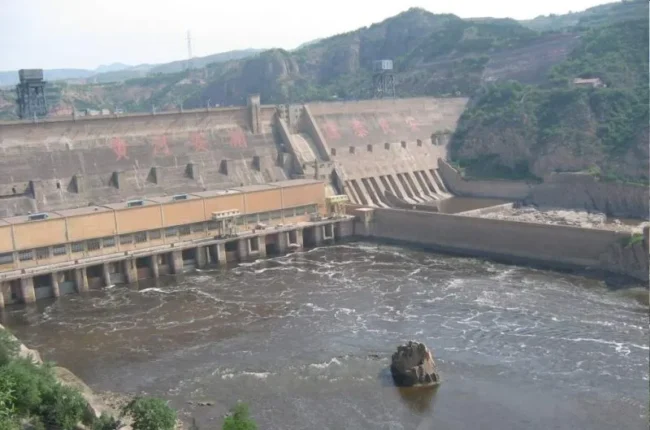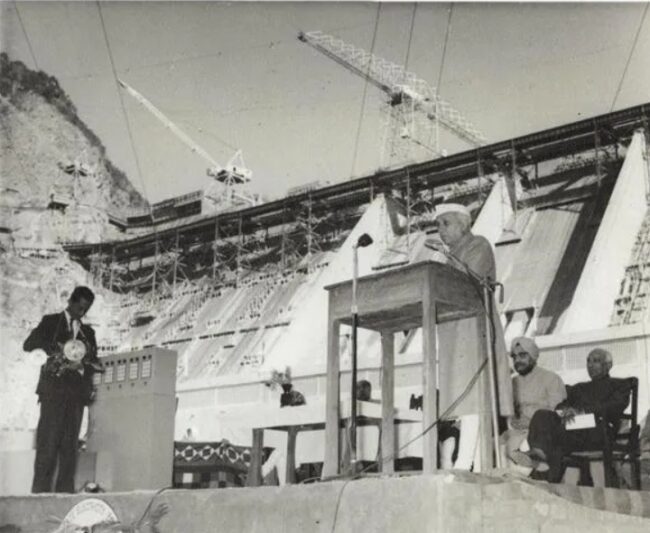
Asit K. Biswas and Cecilia Tortajada
GLOBAL WATER FORUM | October 23, 2025
Both China and India have thousands of years of experience on how to manage water to reduce the impacts of serious floods and droughts. Empires have fallen in both countries when the Kings have failed to manage water properly. Here, Asit Biswas and Cecilia Tortajada discuss how China has overtaken India as the world’s biggest builder of dams, and the importance of dams to both country’s futures.
India became independent in 1947; People’s Republic of China was founded in 1949. In the 1950s, both countries started to construct large dams. India constructed its two major dams, Hirakud in 1953, and Bhakra in 1963. Similarly, China constructed its major dam, Sanmenxia, in 1960.
Results of these constructions were very different. Hirakud and Bhakra were successful. India’s first Prime Minister, Jawaharlal Nehru, proudly proclaimed such large dams as “temples of modern India.” (Figure 1).

In contrast, the record of Sanmenxia was not so auspicious. The dam lost 17% of its storage capacity during its very first flood due to excessive sedimentation. Over next several decades, its design and operating procedures were changed several times for it to remain functional.
In 1980, Chinese Government invited the senior author to assess the feasibility of its largest infrastructure project, the South-North Water Transfer. At that time, confidence of Chinese engineers in building dams was not high, compared to India. Sanmenxia had sapped much confidence.
Post-1990, situations in two countries changed dramatically. China got its dam-building mojo back and became the premier dam-building nation in the world. During the past three decades, it has made major advances in planning and construction of large dams, seriously outpacing India and all other major dam-building nations of the world.
China and India’s policies on large dams’ construction started to diverge in the late 1980s, primarily over resettlement issues. 1990s were a mostly lost decade for dam construction in India. Indian policymakers then believed small is beautiful and big is ugly. Thus, they promoted ideas like rainwater harvesting and construction of check dams over large dams. India’s Supreme Court stopped the construction of Sardar Sarovar Dam for six years when much of it was complete. During this period, World Bank and Asian Development Bank basically stopped financing construction of any large dams. In much of the world, dams had a very poor image.
China, in contrast, continued to build large dams for its economic development. It took a pragmatic approach. After construction of major dams, it assessed what did not work well and modified national policies appropriately so that new generations of dams did not face similar problems.
China further realised construction of large dams enhanced both water and energy security. Energy was particularly important to it since, by 2000, it realised that in less than a decade, it would become the largest oil importer of the world. Thus, it accelerated a programme to construct large dams which would provide flood control, reliable water supply for all human uses, and also be a major generator of renewable energy.
Comparison between the two countries in terms of hydropower development is stark. In 2000, India had 21.8 GW of installed capacity, compared to China’s 77.08 GW. By the end of 2024, difference had become even starker. India’s installed capacity had nearly doubled to 42.72 GW, but China’s had skyrocketed to 435.95 GW, almost 10 times that of India.
Globally, no country can currently compete with China’s advances in dam-building. In 2024, China alone contributed to 14.4 GW of new hydro development, out of total new global capacity of 24.6 GW.
China and India are monsoon countries. This means nearly all their annual rainfalls occur primarily during monsoon months.
Consider one of India’s rainiest cities, Cherrapunji, which receives annual rainfall of 10,820 mm, mostly during June-August. Nearly 80% of this annual rainfall occurs in about 120 hours, not consecutive. Similarly, in Delhi, nearly 80% of annual rainfall occurs in about 80 non-consecutive hours. India experiences intense rainfall over very short time periods. This means a significant part of this rainfall has to be captured and stored by whatever means possible so that water is available throughout the year for all human requirements. This means water must be stored by large, medium and small dams, as groundwater and rainwater harvesting.
Unfortunately, India’s record of dam construction since 1980 has been poor. Consequently, the country has been facing serious water scarcity problems for several decades. Cherrapunji, with its extraordinary annual rainfall, has been facing serious water scarcity problems in non-rainy seasons because lack of storage structures.
India’s population is estimated to increase to 1.7 billion by 2050. Vision 2047 targets India’s GDP to increase 10-fold by 2047. Furthermore, all Indians expect far better standard of living by 2050. Unless the country builds quickly all types of water storage structures, including large dams, its future socioeconomic development would be in peril.
Climate change is making intense rainfalls more intense and frequent, making need for water storage even more important. India knows how to plan and design all types of good and sustainable storage structures. Unless it completely restructures its water infrastructure and construction policies urgently, it is going to face serious water scarcity problems, which no other earlier generation has ever had to face.
Asit K. Biswas is director of Water Management International, Singapore, and distinguished visiting professor at the University of Glasgow, Scotland; and Cecilia Tortajada is honorary professor at the University of Glasgow, Scotland. Both are visiting professors at Centre for Policy Research, New Delhi.
This article was published by GLOBAL WATER FORUM, October 23, 2025.